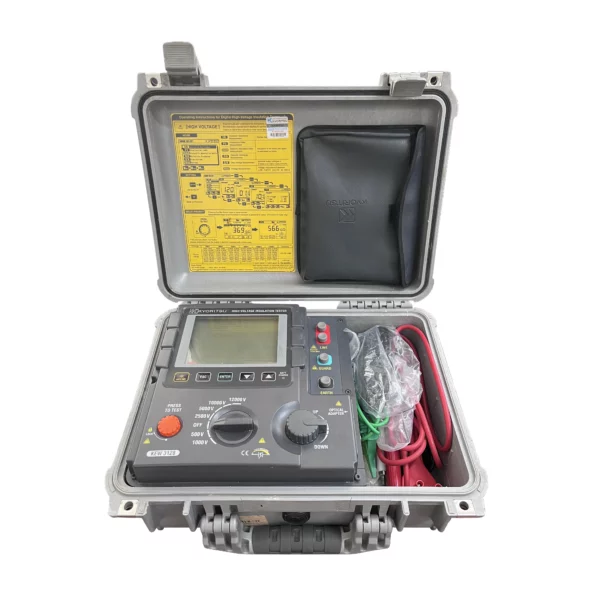High Voltage Insulation Resistance Testers (HVIR testers) come in various types, each designed for specific applications and varying in functionality.
Here are some common types and their differences in functionality:
- Handheld Megohmmeters: These portable devices are suitable for insulation resistance testing in various electrical equipment, cables, and motors. They typically operate at lower voltages (often up to 1000V or slightly higher) and are used for quick on-site insulation resistance measurements.
- Motor Insulation Testers: Specifically designed for testing the insulation of motors and generators, these testers often feature a broader range of test voltages and additional functionalities tailored for motor winding insulation testing.
- Diagnostic Insulation Testers: These testers are more advanced, offering higher voltage outputs (up to several kilovolts or more) and are equipped with diagnostic capabilities, such as polarization index (PI), dielectric absorption ratio (DAR), and timed resistance ratio (TRR) measurements. They provide a more comprehensive assessment of insulation condition in high voltage systems.
- Portable Insulation Testers: Designed for field use, these testers are compact, rugged, and offer a wide range of test voltages. They often feature data logging capabilities, wireless connectivity for remote monitoring, and may comply with specific industry standards.
- Benchtop Insulation Testers: These testers are designed for laboratory or workshop settings. They offer higher accuracy, precision, and often have more extensive test voltage ranges. Benchtop models may include additional features such as graphical displays, programmable testing sequences, and extensive data storage capabilities.
- High Voltage Insulation Resistance Test Sets: These are heavy-duty testers used in high voltage installations, power plants, substations, or large industrial settings. They provide significantly higher test voltages (up to several tens of kilovolts) and are capable of testing large electrical systems and equipment.
The differences in functionality among these testers primarily revolve around their voltage range, accuracy, portability, additional diagnostic capabilities, data logging, connectivity, and suitability for specific applications (e.g., motor testing, high voltage systems, field use, or laboratory settings).
When selecting an HVIR tester, consider the intended application, required voltage range, accuracy, portability, diagnostic features, High Voltage Insulation Resistance Tester safety features, compliance with standards, and any additional functionalities needed for comprehensive insulation resistance testing in specific electrical systems or equipment.
How do High Voltage Insulation Resistance Tester contribute to predictive maintenance strategies in electrical systems?
High Voltage Insulation Resistance Testers (HVIR testers) play a crucial role in predictive maintenance strategies for electrical systems by aiding in the assessment of insulation health. Here’s how they contribute:
- Early Detection of Insulation Deterioration: HVIR testers help detect early signs of insulation degradation or weaknesses in electrical components, cables, transformers, motors, and other equipment. By regularly measuring insulation resistance, they identify potential faults before they escalate into major issues.
- Preventive Measures: Regular insulation resistance testing with HVIR testers allows maintenance teams to proactively address insulation problems. This proactive approach helps prevent unexpected equipment failures, downtime, or costly repairs.
- Condition-Based Maintenance: HVIR testers provide quantitative data regarding insulation resistance values over time. Trend analysis helps maintenance teams establish baseline values and monitor changes in insulation resistance, enabling condition-based maintenance schedules rather than fixed interval-based approaches.
- Diagnosis of Insulation Health: HVIR testers often include diagnostic functions such as polarization index (PI), dielectric absorption ratio (DAR), and timed resistance ratio (TRR) tests. These tests provide deeper insights into the insulation condition, indicating moisture ingress, surface contamination, or other issues affecting the insulation’s integrity.
- Risk Mitigation: Identifying and rectifying deteriorating insulation in advance mitigates the risk of insulation breakdown, which could lead to electrical faults, short circuits, or equipment damage. It enhances safety for personnel and prevents potential hazards.
- Asset Life Extension: Regular insulation resistance testing helps extend the life of electrical assets. Timely identification and rectification of insulation problems prevent premature equipment failure, reducing the need for costly replacements and extending the lifespan of electrical systems.
- Compliance with Standards: Many industries and regulatory bodies require regular insulation resistance testing to comply with safety and quality standards. HVIR testers facilitate adherence to these standards by providing documented records of insulation resistance measurements.
- Data-Driven Decision Making: HVIR testers generate quantitative data that can be stored, analyzed, and used for making informed maintenance decisions. This data-driven approach enables prioritization of maintenance activities based on criticality and urgency.
By integrating High Voltage Insulation Resistance Testers into predictive maintenance programs, organizations can adopt a proactive stance toward equipment health, reduce unplanned downtime, optimize maintenance costs, and ensure the reliability and safety of electrical systems in various industries.

